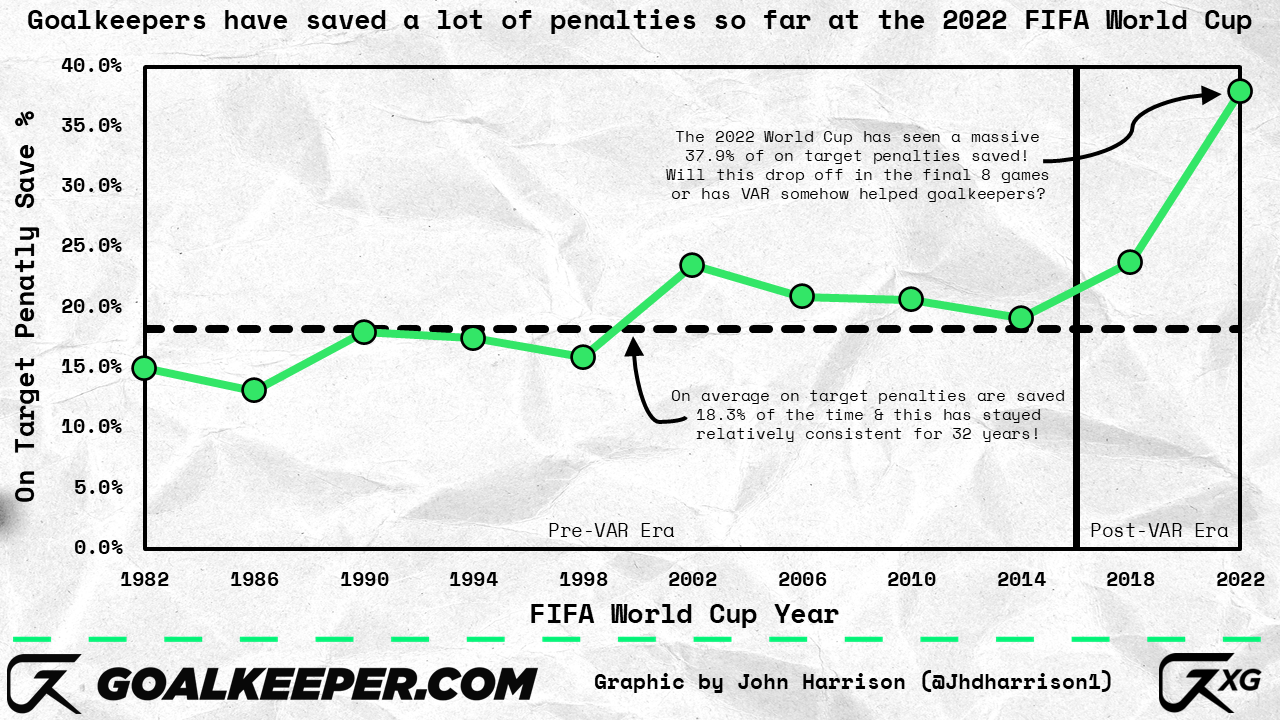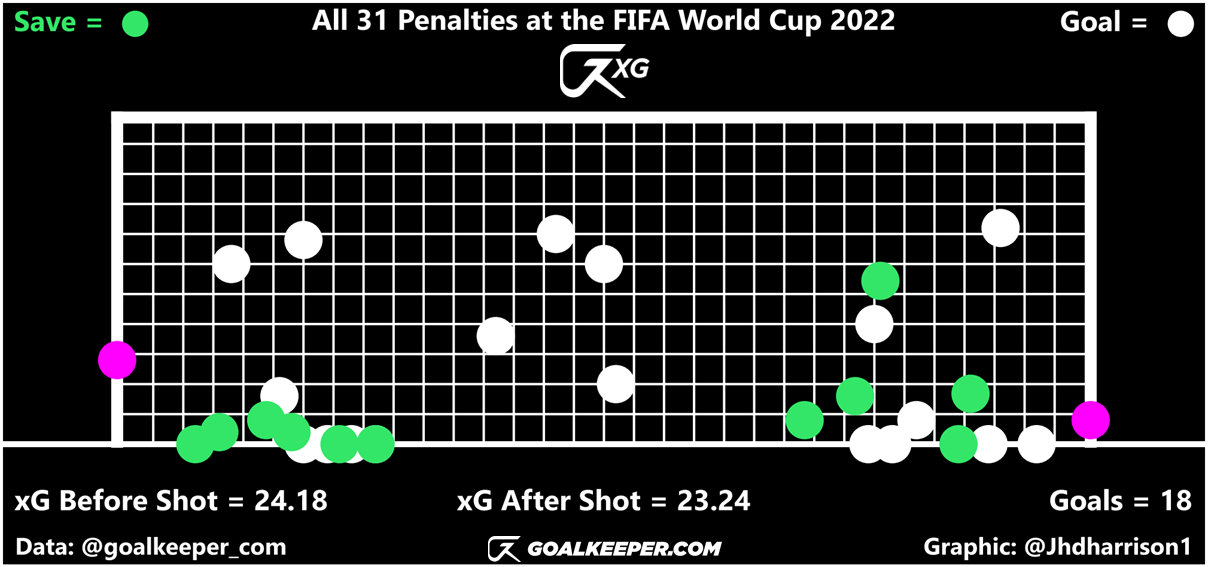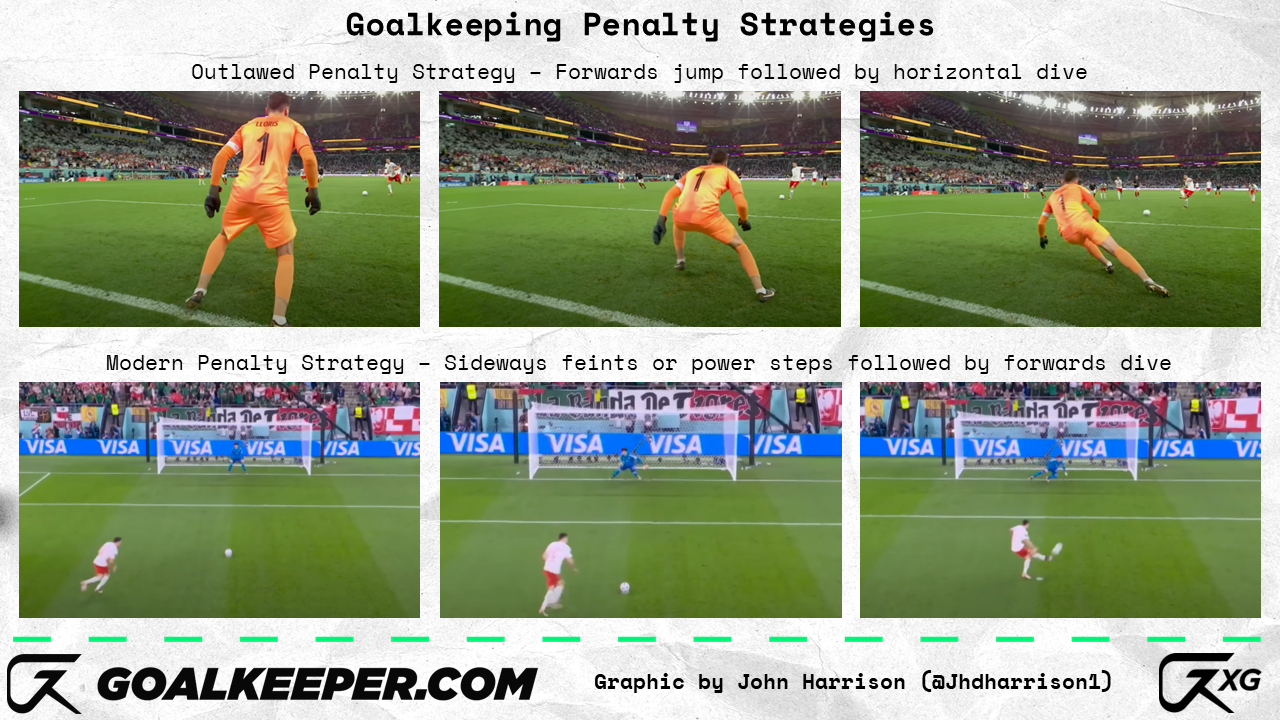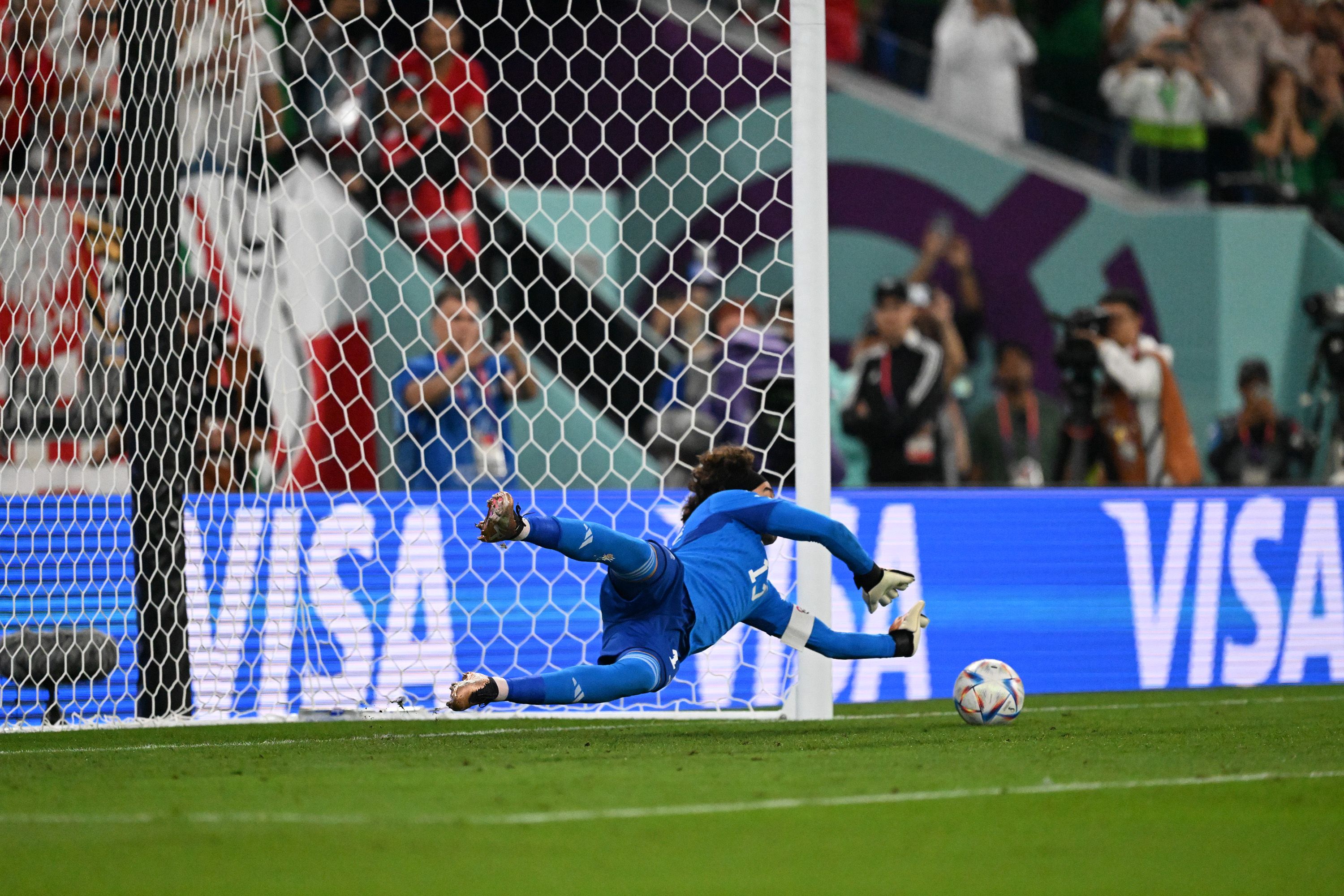Astronomer Goalkeeper Dr. John Harrison digs into the data to find out whether the number of penalty saves we have seen at this World Cup is unprecedented…
As we head into the quarter finals of the 2022 edition of the FIFA World Cup, many fans and pundits have noticed that goalkeepers seem to be saving a lot of penalties this year. Indeed, they are not mistaken.
Of the 31 penalties that have been taken thus far (including in game penalties and shootout penalties) just 18 have been scored, with two hitting the post, and an incredible 11 being saved by the goalkeeper. This puts the penalty save percentage at a huge 37.9%. However, the graphic below highlights how this percentage is actually not at all usual for the World Cup tournament.

Since the 1982 tournament in Spain, when the first World Cup penalty shootout occurred, the rate at which goalkeepers have saved on target penalties has remained relatively stable. On average, 18.3% of on target World Cup penalties get successfully repelled by the goalkeeper. This rate is similar to the rate in the Premier League where, over the last 18 years, 17.3% of all on target penalties have been saved. This information shows just how unusual a penalty save rate of 37.9% is, given that various large samples of data suggest penalties should be saved less than one fifth of the time.
So why have so many penalties been stopped at this tournament? The graphic below shows the locations of the 31 penalties taken so far at the World Cup. The penalties which have been saved are shown as green circles, while the missed penalties are shown as magenta circles, and the scored penalties are shown as white circles.

The first thing we notice about the placement of the penalties is that an overwhelming amount of them have been hit low to the ground thus far. In fact 74.2% of penalties so far have not been substantially lifted off the ground. This is far above the norm as historically in the Premier League and at past World Cups only 50% of penalties are aimed low.
Why could this be? To begin with, England full back Kieran Trippier was quoted as saying “I feel the ball is a bit lighter. It feels like if you put too much power on it it will just fly away” at the start of the tournament. It could be that penalty takers are quite rightly worried about blazing a penalty over the bar and thus are more reluctant than usual to lift the ball off the ground.
An interesting consequence of this is that the save percentage of penalties hit into the lower third of the goal historically is around 24% while the save percentage of penalties hit into the upper two thirds of the goal historically is around 12%. The trend to hit penalties low has certainly increased the chances of seeing the ball saved but this explanation would only provide an increase in the penalty save percentage to 21%, i.e. we would've only predicted around six penalties to have been saved rather than 11!
At Goalkeeper-xG, our penalty model goes further than the simple argument I put forward above but it still does not answer our question. Goalkeeper-xG’s model uses not only the vertical placement of the ball but the horizontal placement and the velocity of the strike to predict how likely a penalty is to be scored. At the FIFA World Cup so far, the model has found a similar result to using the simplistic assumptions I outlined above as it predicts 23.24 penalty goals to have occurred due to the placement and power of the on target penalties. Again, this only corresponds to seeing around six saves.
So how have we seen 11 penalty saves if it cannot be solely explained by poor placement and power from the takers? For me, there are two possible explanations.
Firstly, it could just be a small sample size effect and that the true penalty save percentage is still around 18% (as has been average for past World Cups). For this to be true, it would require that we are currently seeing a goalkeeping hot streak in our small sample and therefore we are due a streak of penalties all being scored at some point in order for the save probability to even out.
We can test this mathematically by looking at the probability that the sample of penalties from past World Cups and this World Cup are taken from the same distribution. However, when we do this we only find a 0.75% chance that this is the case. So we may just be living in a world where goalkeepers are on a penalty hot streak but that is highly unlikely. It is not at all probable that you find yourself ever in a run of 11 penalty saves from 29 on target penalties (but it is obviously not impossible that this is the case).
Therefore, I am more inclined to think that the explanation is more likely due to another reason. The second reason I am suggesting is that goalkeeper’s have actually become better at saving penalties and that the goalkeepers at this tournament are actually inherently above average penalty savers. One thing the first graphic highlights is that actually the second highest penalty saving World Cup on record was the 2018 edition of the tournament. This makes me believe that the introduction of VAR might actually be behind all of this.
The reason VAR could be the explanation is that now goalkeepers will basically always get penalised and the penalty will be retaken if they move off their line before the ball is struck, as Hugo Lloris found out against Poland. Therefore, goalkeepers have had to adjust their penalty saving routines such that they make sure they keep one foot on the line until after the ball is in motion. While this may seem like a big disadvantage for the goalkeeper, a few people in the goalkeeping world, including myself, suggested the stricter enforcement of the rules may actually help the goalkeepers.
Below are a selection of screenshots highlighting the now very much outlawed (it was always against the rules but referees were very lenient when enforcing it) jump-forwards-then-dive penalty strategy and the modern law abiding move-horizontally-then-dive-forwards strategy.

The two big advantages of the modern penalty strategy are that it maximises the goalkeeper’s reaction time while also forcing the goalkeeper into performing a cleaner diving technique.
By hopping off his line before the penalty is struck, Lloris (in the example above) loses vital extra reaction time as he has turned a 12 yard shot into a 10.5 yard shot. Given the shot is so central there is very little advantage to be gained by cutting down the angle such a small amount especially given how much curl players can put on the ball these days.
Yes, closing the angle means the goalkeeper covers more of the goal mouth area around them but it also makes it more likely that the pace on the ball will beat them and the shot will deflect off them and go in or squirm under them. The additional disadvantage of the outlawed strategy is that the shuffle forwards often wrong foots the goalkeeper and forces them to take a negative-step horizontal dive as you can see with the screenshot of Lloris above.
A negative step dive is one where. rather than pushing off the foot closest to the ball and maximising the goalkeeper’s dive range, the goalkeeper sweeps their leg away from underneath them and ‘collapses’ down to the ground as quickly as possible and therefore decreases their dive range to adjust their arms' initial reach. The negative step dive has a place in a goalkeeper’s armoury but it is not useful when facing penalties as it makes it almost impossible to save penalties fired into the corners, regardless of their power.
Additionally, the initial movement also means this dive is usually very horizontal rather than forwards and therefore can often lead to the goalkeeper parrying the ball into the side netting rather than away from the goal.
The modern strategy, however, almost forces the goalkeeper to make a power step dive which has a vertical component as it is not fully horizontal or backwards. The advantage of the power step dive is that it can propel a goalkeeper all the way to the corner of the goal and can give them a saving length which is greater than their initial reach. On top of that, the fact that the dive has a vertical component means that it is more likely to generate enough force to push the ball away from the net.

Moreover, horizontal motion across the line can be utilised in conjunction with the modern strategy, as Ochoa showed vs Poland (and famously Sommer showed vs Jorginho at EURO 20220), to make it appear that the goalkeeper is going one way before switching to the other direction without any loss of reaction time. The one disadvantage of this dummying strategy is that it forces a reduction in the goalkeeper's dive range unless they can get a second step in. However, this is only an issue if the penalty is placed near the corner, and against strikers who stutter in their run up, concealing the direction of your dive is often far more important than dive range.
So, for those reasons, maybe the fact that FIFA, via the introduction of VAR, have forced more goalkeepers to adopt the modern strategy during penalties has inadvertently caused many goalkeepers’ penalty saving skills to become more refined and therefore make them more likely to produce a save.
‘Only time will tell’ is a cliché, but mathematically it is true; statistically, only time will tell whether we are just in a hot streak of penalty saving, or if goalkeepers have genuinely become better at stopping penalties.








